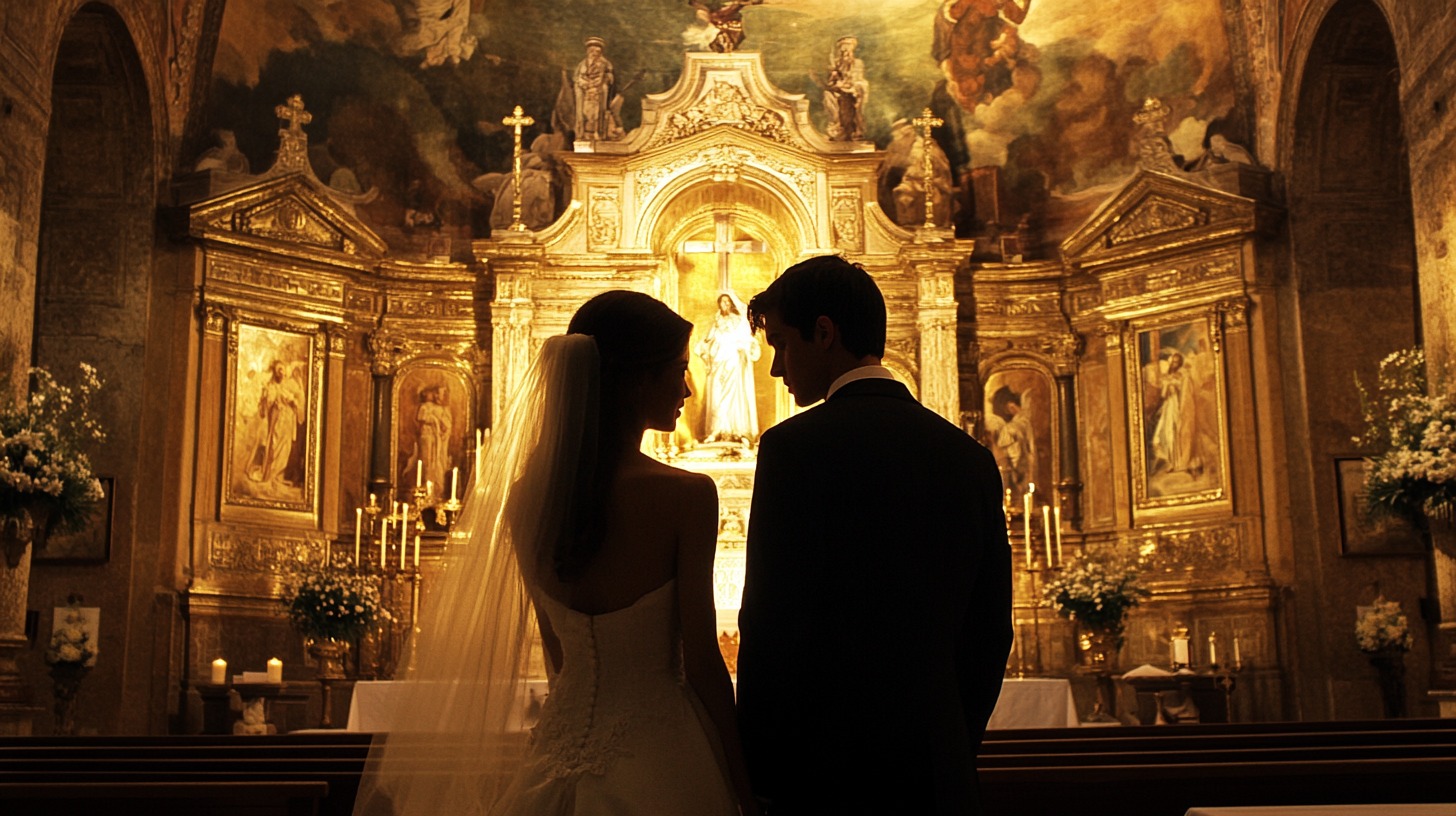The Catholic Church views marriage as a sacred and indissoluble union, firmly rooted in scripture and tradition.
For Catholics, marriage is more than just a contract. It is a covenant that binds a couple for life.
However, complexities arise when a Catholic wishes to marry someone who has been previously divorced, particularly if that person is not Catholic.
The situation poses challenges, requiring both parties to navigate Church teachings, procedures, and sometimes lengthy processes to align with the Church’s views on the sanctity of marriage.
Let us talk about it.
Process for a Divorced Non-Catholic Seeking to Marry a Catholic
A Catholic who marries a divorced non-Catholic without obtaining the necessary annulment and permissions places themselves in a state that the Church considers sinful, thereby making them ineligible to receive Communion.
When a Catholic wishes to marry a divorced non-Catholic, the Church’s requirements become more intricate to ensure the union aligns with its teachings.
Here’s a breakdown of the steps involved:
Annulment Process
Before the marriage can be recognized by the Church, the divorced non-Catholic must undergo the annulment process through a Church tribunal.
If an annulment is granted, it means that the previous marriage lacked some essential elements required for validity, thus allowing the couple to proceed with a Church wedding.
Without an annulment, the Catholic Church considers the divorced person still bound to their previous spouse, making a new marriage invalid in the Church’s eyes.
Special Permissions for the Catholic Partner
- Required if the non-Catholic partner is baptized in another Christian denomination. The permission acknowledges the spiritual significance of the union, despite differences in religious practice.
- Necessary if the non-Catholic partner is unbaptized. The dispensation allows the marriage to be recognized even when one partner does not share the Catholic faith.
By requiring these permissions and dispensations, the Church aims to:
- Uphold its teachings on the sacrament of marriage, which is one of seven sacraments.
- Offer pastoral support to couples in unique circumstances, balancing doctrinal adherence with compassion.
Catholic Church’s Stance on Marriage and Divorce

In the Catholic Church, marriage is regarded as a lifelong covenant that reflects Christ’s unwavering commitment to His Church.
This view is deeply rooted in scripture, particularly in the Gospel of Matthew (19:6), where Jesus emphasizes:
“So they are no longer two but one flesh. What therefore God has joined together, let not man separate.”
- A binding, lifelong union that cannot be dissolved simply because of personal differences or challenges.
- A sacrament, which serves as a visible sign of God’s grace, sanctifying the bond between a husband and wife.
Therefore, the Church does not recognize divorce in the way civil law does. Instead, it maintains that:
- A validly entered marriage is indissoluble, meaning it cannot be broken by any human authority.
- A civil divorce does not end the marriage in the eyes of the Church.
The implications for Catholics are significant:
- A person who is legally divorced is still considered married by the Church unless an annulment is obtained.
- Without an annulment, a divorced individual cannot remarry within the Church, as this would be seen as adultery.
The Church upholds that all marriages, even those outside of Catholic settings, are to be respected and hold spiritual significance.
However, to marry again within the Church, an individual must undergo a formal process to determine if the previous marriage was invalid.
Recognition of Marriages by the Catholic Church

The Catholic Church recognizes marriages conducted outside of its sacramental ceremonies.
Whether the union was officiated in a courthouse, a Protestant church, or even a non-Christian setting, the Church generally acknowledges these marriages as valid.
- All marriages are seen as natural unions that deserve respect.
- Even without the sacramental nature of a Catholic wedding, such unions are still valued.
However, complications arise when a Catholic wishes to marry someone who has been previously divorced.
In such cases, the Church requires an in-depth examination of the prior marriage through the annulment process. This process is crucial to determine if the previous marriage was valid according to Church teachings.
- Annulment necessity: Before entering a new marriage, an annulment is required to confirm that the original marriage was not valid in the Church’s view.
- Grounds for annulment: If the Church finds that certain conditions were not met, it may declare the previous marriage null.
- Permission to remarry: Once an annulment is granted, the divorced individual is free to marry again within the Catholic Church.
What is an Annulment?
An annulment, contrary to popular belief, is not simply a “Catholic divorce.” Instead, it is an official declaration that, despite being legally binding, a marriage was not valid according to Church law.
It means that, in the eyes of the Church, the marriage never truly existed as a sacramental union.
The annulment process involves a thorough review of the circumstances surrounding the original union to determine whether certain impediments existed that would have made a valid marriage impossible.
- Lack of understanding of marital responsibilities: If one or both parties were not fully aware of the lifelong commitment marriage entails.
- Coercion or pressure: If either party was forced or unduly pressured into the marriage.
- Psychological incapacity: If one spouse lacked the mental capacity to understand or fulfill the obligations of marriage.
- Inability to commit: If one party entered the marriage without the genuine intention of upholding the vows or remaining faithful.
For instance:
If one or both partners did not comprehend the seriousness of their vows, or if they were pressured into the union, the Church may consider the marriage invalid.
Recent Developments and Church Reforms

In recent years, the Catholic Church, under the guidance of Pope Francis, has made significant strides to simplify the annulment process, aiming to make it more accessible and less burdensome for the faithful.
In his 2015 reforms, the Pope emphasized the need to alleviate unnecessary delays and reduce the complexity of the process for those wishing to align their lives with Church teachings.
The reforms include several key procedural changes designed to streamline the annulment process, especially for straightforward cases.
Key Reforms and Procedural Changes:
- Introduction of a shorter process for clear-cut cases.
- Simplified documentation requirements to ease the burden on applicants.
- Greater reliance on diocesan bishops to expedite decisions in specific cases.
Elimination of Mandatory Appeal:
- Previously, every annulment decision required a mandatory second review.
- This step has now been removed, allowing for faster resolutions.
Fee Reductions:
- In many dioceses, fees associated with the annulment process have been reduced or eliminated to make it more accessible, especially for those with financial difficulties.
- Beyond these procedural changes, there is ongoing dialogue within the Church on how to better support couples in complex marital situations:
Pastoral Focus and Support Initiatives:
- Enhanced Spiritual Guidance
- Emphasis on providing compassionate pastoral care while upholding the sanctity of marriage.
The Bottom Line
The Catholic Church remains steadfast in its commitment to preserving the sanctity of marriage while offering pastoral care to those in difficult marital situations.
For those interested in marrying within the Church, exploring the annulment process is essential to ensure that their union aligns with Catholic teachings.
By upholding its principles while embracing reforms, the Church continues to walk the delicate line between tradition and compassion.
